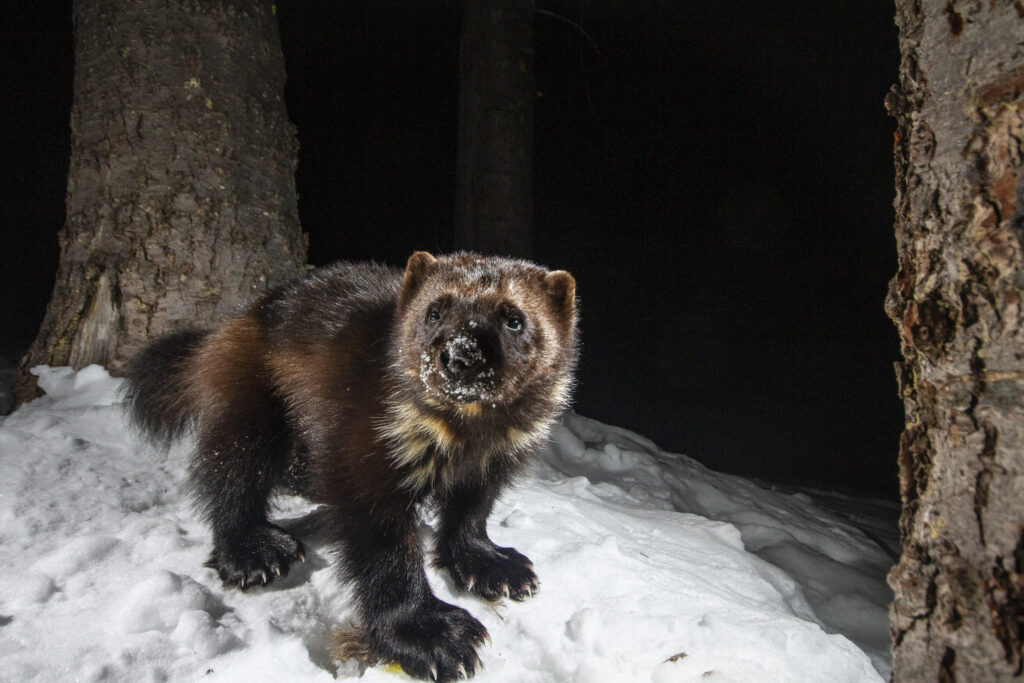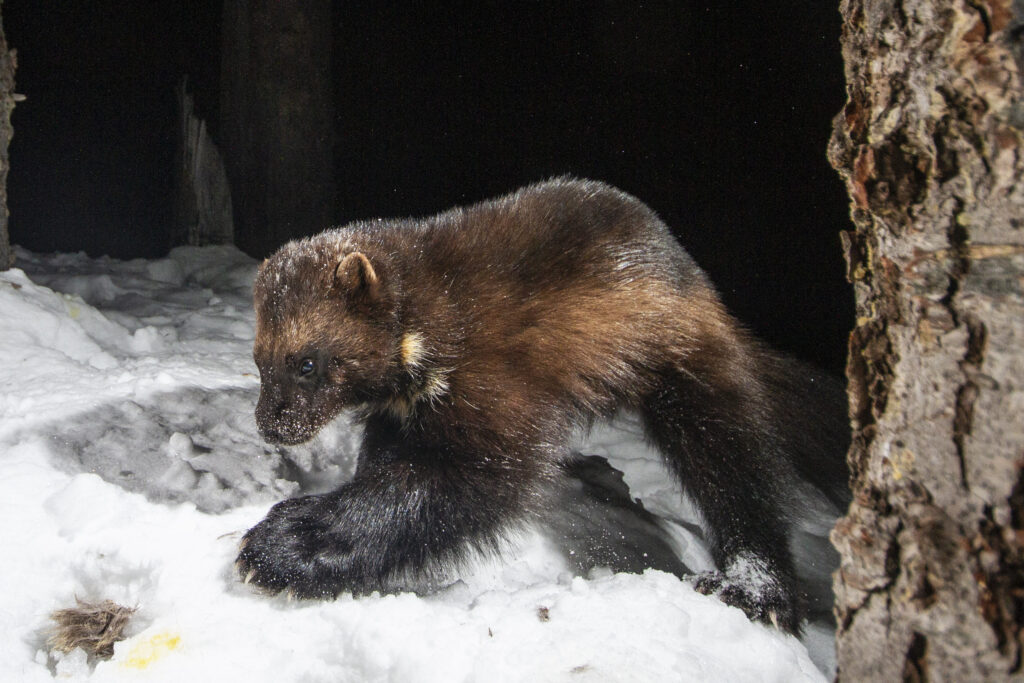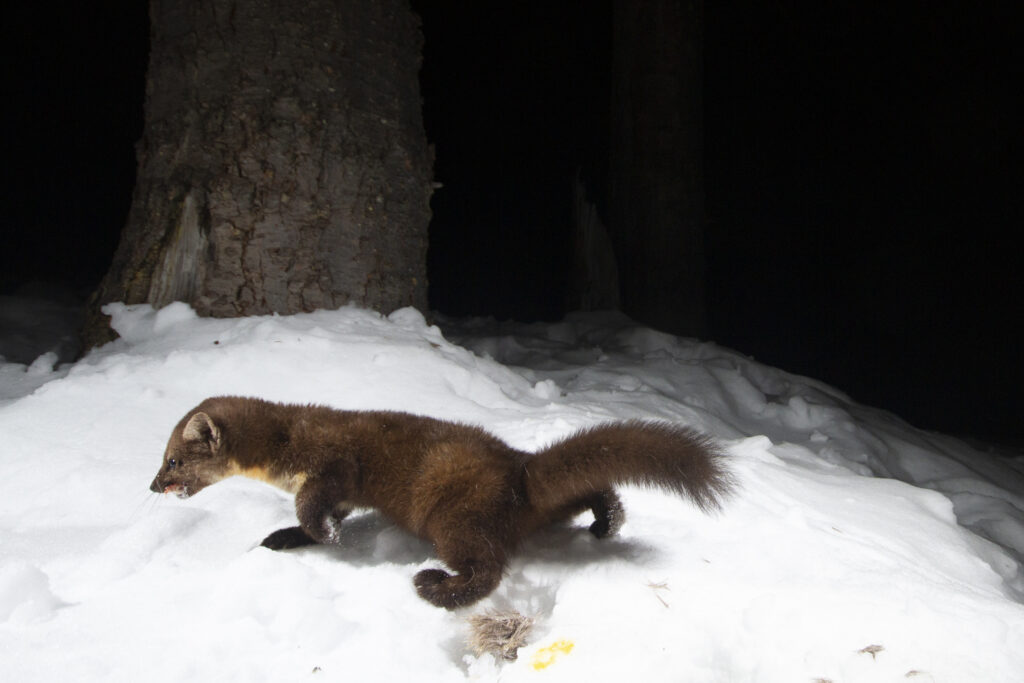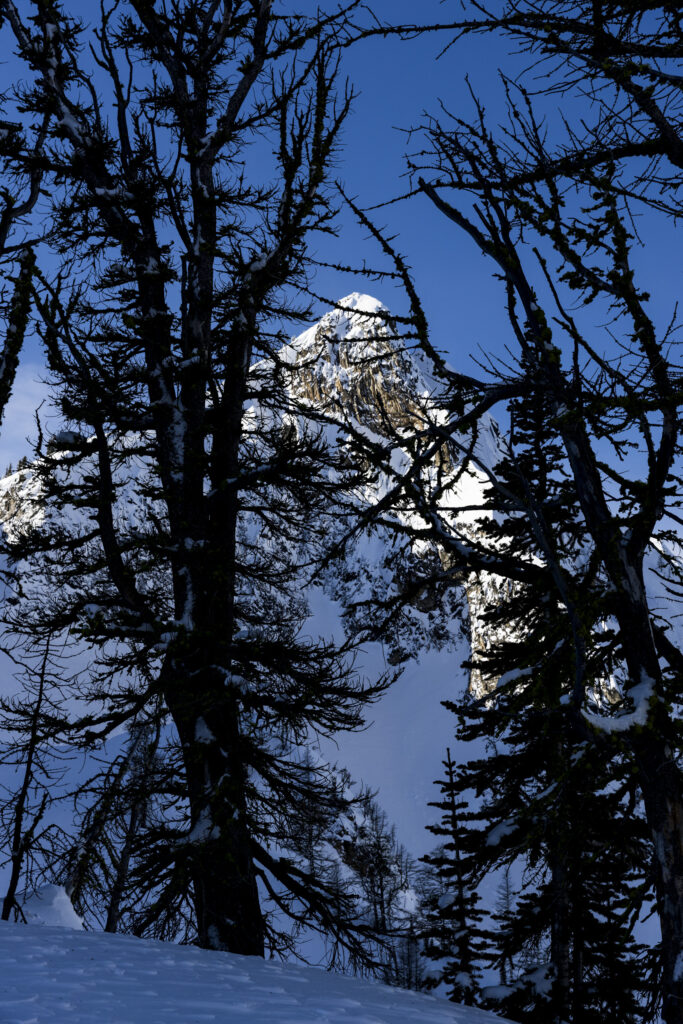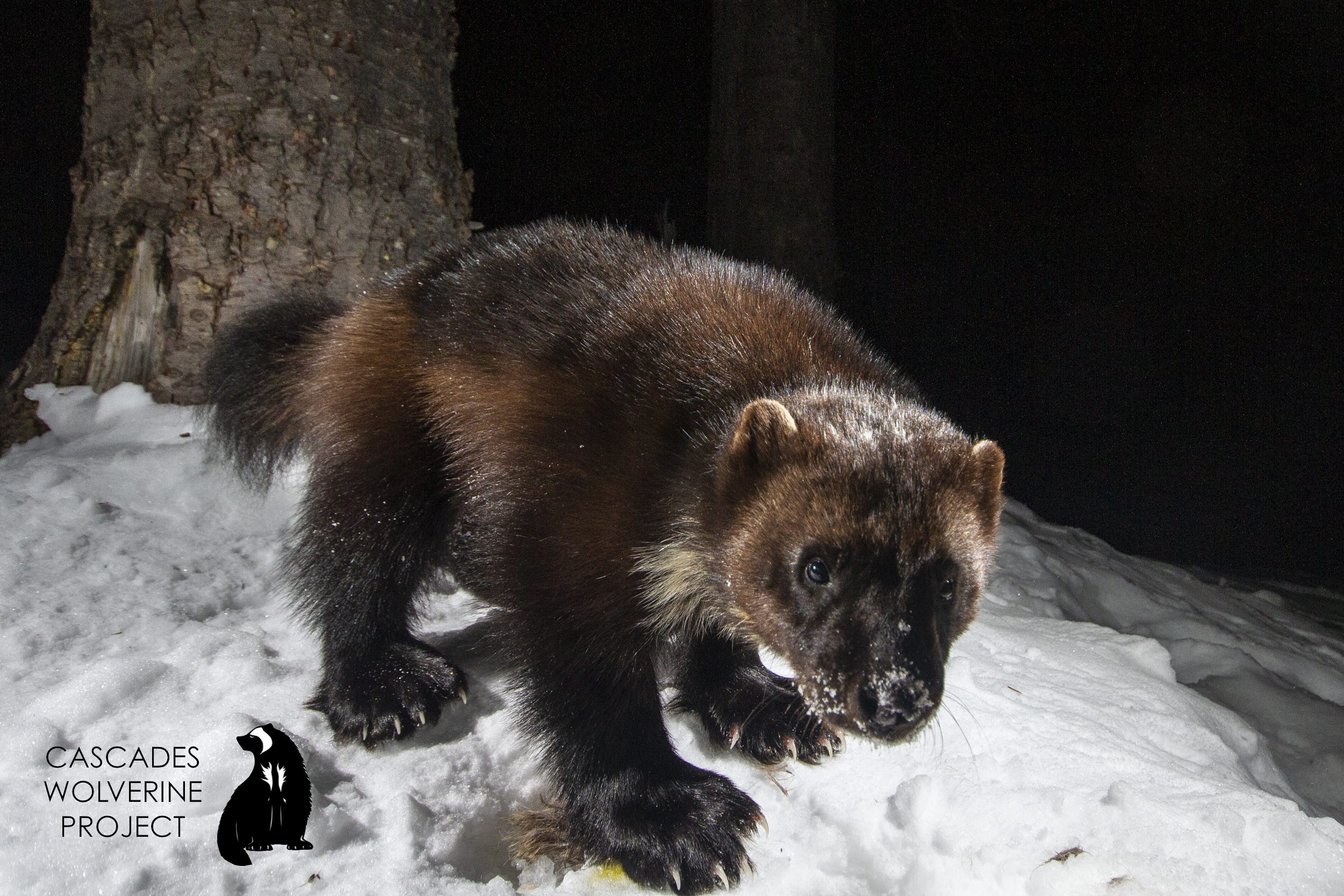Prepared by Steph Williams and David Moskowitz

Introduction
Based in the Methow Valley of North Central Washington, Cascades Wolverine Project aims to support wolverine recovery in the Cascade Mountains through monitoring, community science, and storytelling. The project team includes David Moskowitz, Drew Lovell, and Steph Williams, along with many skilled volunteers including a dedicated crew: Jesse Snyder, Nick March, Jack McLeod, Peter Loft, Alyssa Lovell, and Holden Village staff. Anna Machowicz assists with research, and Claire Waichler contributes to data management. We work in collaboration with Conservation Northwest (CNW), Wildlife Conservation Society Canada (WCS), University of Utah (UU), Laboratoire des Sciences du Climat et l’Environnement, France (LSCE), Woodland Park Zoo (WPZ), Pacific Northwest Research Station (PNW), U. S. Forest Service (USFS), Washington Department of Fish & Wildlife (WDFW), and Cascades Carnivore Project (CCP). CWP is a member of the Washington Wolverine Research and Monitoring Group. Funding has been provided by Patagonia’s Environmental Grants Program, private donations, and corporate match donations. The project fiscal sponsor is Conservation Northwest.
Methods
Objective 1: Monitoring
Monitoring area – We installed remote-camera stations within the northern and eastern portions of the North Cascades Ecoregion, specifically in the Chelan and Methow watersheds of Okanogan-Wenatchee National Forest, and the North Fork Nooksack watershed of Mt. Baker National Forest. In collaboration with John Rohrer (retired, USFS), and Scott Fitkin (WDFW) we chose specific drainages based on findings of the North Cascades Wolverine Study (2005-2015), and current efforts by Woodland Park Zoo Senior Conservation Scientist Robert Long of the North Cascades Wolverine Project (2013-present.) We maintained monitoring stations in the same or nearby locations as the previous four years, pairing stations within each drainage at high and low elevations. All sites fell within the bioclimatic envelope predicted to be wolverine habitat as described by Copeland, et al. (2010), and were accessible within a day by snowmobile and ski from the Methow Valley, the village of Holden, and the Nooksack watershed.
Methods – We installed and maintained eleven remote camera stations baited with Gusto scent lure (a skunk and beaver castor-based attractant) and roadkill deer. Additionally, each station included a hair sampling device to collect genetic data. Two stations utilized run-poles for genetic sampling (Holden-2019-1, Ptarmigan-2021-1), and all other stations were each equipped with a gun-brush hair snag strap attached to a tree. We co-managed two stations with CNW volunteers (Holden-2019-1, Ptarmigan-2021-1). Three stations were installed and removed by CWP and CNW volunteers (Ptarmigan-2021-1, Silver Star-2020-1, Holden-2019-1). At six stations we suspended bait two to three meters above the snow surface with cable hung between trees: Holden-2019-1, Holden-2019-2, Holden-2019-3, Ptarmigan-2021-1, Early Winters-2017-2, Early Winters-2017-3. At all other stations we attached bait directly to a tree.
We maintained stations every three to four weeks between January and March 2022, removing all stations between April and August 2022 (see Table 1). We sent field updates directly to biologists Cathy Raley, John Rohrer, and Scott Fitkin, as well as to Mt. Rainier National Park and Jocelyn Akins (CCP) whenever relevant to their study areas. Genetic samples were mailed to Cathy Raley (PNW) and shipped to the National Genomics Center for Wildlife and Fish Conservation at Rocky Mountain Research Station. Data from our project (2017-present) is currently being uploaded and processed on Wildlife Insights, a cloud-based platform which utilizes artificial intelligence to help identify species detected by remote camera traps.
Objective 2: Community Science – Public Incidental Wildlife Observations
Study Area: Primarily Washington’s Cascade Mountains.
Methods: Through regional and national news, social media, our website, public events, project partners, and personal correspondence, we gathered public observations of wolverines and other rare wildlife, and wildlife tracks. This information was evaluated for accuracy and catalogued along with track observations made directly by project members over the course of winter field work. In collaboration with research partners, we conducted a test to measure observer reliability using CWP methods for identifying and classifying tracks using photographs submitted to us by the public. Test results are currently under analysis, with the aim to submit for publication this year.
Objective 3: Conservation Messaging
A third objective of CWP is to create and disseminate visual content and narratives designed to engage and educate the public about wolverine conservation on a regional and national scale. Photographs and “stories from the field” are shared via social media, e-news, and partner organizations. CWP also contributes images to journalism and invites media coverage of wolverine conservation. We amplify work from other organizations that benefit wolverine conservation, including for example Conservation Northwest’s campaign to pass the Recovering America’s Wildlife Act. We do multiple talks each year at schools, outdoor retailers and outfitters, and conservation organizations.
Results
Objective 1: Monitoring review
Of eleven stations, two stations detected wolverines this year, which constitutes the fewest wolverine detections the project has had in five years of monitoring. Notably, for the first time during our monitoring effort, one station detected a wolf. Also of note, for the third consecutive year, we did not detect wolverines in the Early Winters watershed. Consistent with past winters, sites near Holden Village produced the most frequent wolverine detections, with a total of four detection events. During station checks, field crew encountered and photographed a ptarmigan, which is considered rare in our study area, as well as fresh wolverine tracks. The wolverine tracks occurred in February near a Holden camera station during a 16-hour period between visits to service the station. We followed the trail backwards to find a location beneath a large boulder where the animal appeared to have stayed for some time, given the relatively melted state of the tracks leading into the boulder versus out from it.
Table 1. 2022 CWP wolverine and rare species photographic detection events across all stations
| Camera Station ID | Installed | Removed | No. of Events | Species | |
| 1 | Ptarmigan-2021-1 | – | – | ||
| 2 | Holden-2019-1 | – | – | ||
| 3 | Holden-2019-2 | 3, 1 | Wolverine, Ptarmigan | ||
| 4 | *Holden-2019-3 | 1 | Wolverine | ||
| 5 | Twisp River-2017-2 | 1 | Wolf | ||
| 6 | Twisp River-2022-1 | – | – | ||
| 7 | Early Winters-2017-2 | – | – | ||
| 8 | Early Winters-2017-3 | – | – | ||
| 9 | Silver Star-2020-1 | – | – | ||
| 10 | Harts Pass-2020-2 | – | – | ||
| 11 | West Fork-2022-1 | – | – |
*A second wolverine event occurred at this site, evident via definitive wolverine tracks. Researchers followed the animal’s trail backward to a recently used (< 24 hours) wolverine bedding site.
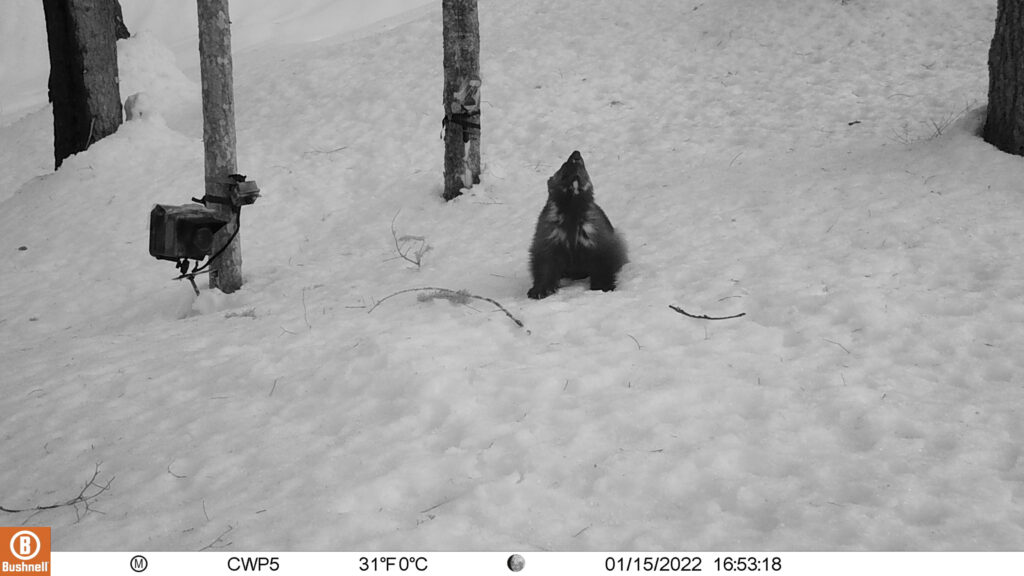
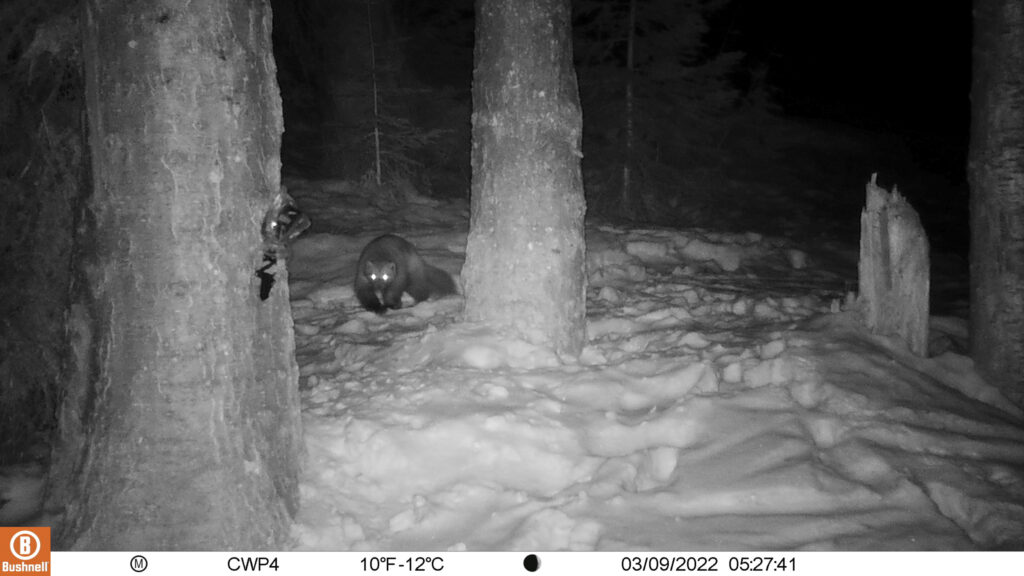
Objective 2: Community science review – public wildlife observations
In 2021-2022 we saw a slight increase in the number of public observations and a decrease in the number of verifiable wolverine sightings. Notably, public observed a group of two wolverines at Mt. Rainier National Park, and a group of three wolverines in the Glacier Peak Wilderness. We received our second verifiable report of Canada Lynx. Most observations submitted to CWP were of animal tracks. Table 3 summarizes public observations submitted per year, including verifiable sightings.
While track observations have been an invaluable clue to help direct the installation of camera trap stations, CWP has thus far only reported on community observations which included photos of actual animals, despite track observations making up most of the observations submitted by the public. In the fall of 2021, we initiated an experiment to test the reliability of our expert review methods for community science track data. For this experiment, we are collaborating with Anna Machowicz (Home Range Wildlife Research), Dr. Jeff Rose (University of Utah), Dr. Matthew Scrafford (Wildlife Conservation Society of Canada), and Dr. Philippe Naveau (Laboratoire des Sciences du Climat et de l’Environnement, France).
We are currently completing analysis of this experiment and will present the results of this study along with its implications for track observations in the months to come. With our methods tested, we also look forward to significantly expanding our community science effort. To prepare for this we are working with volunteer Peter Lambert to develop a more streamlined user interface for collecting, evaluating, and sharing our community science data. Development and implementation of this new system is currently underway.
Table 3. Community science program: public incidental wildlife observations received per year
| Year** | No. of observations | Wolverine* | Lynx* | Cascade Red Fox* | Region |
| 2017-2018 | 12 | 1 | 0 | 0 | NCE |
| 2018-2019 | 27 | 3 | 0 | 0 | NCE |
| 2019-2020 | 93 | 8 | 0 | 2 | NCE & SCE |
| 2020-2021 | 57 | 19 | 1 | 0 | NCE & SCE |
| 2021-2022 | 60 | 14 | 1 | 0 | NCE & SCE |
| Total | 249 | 45 | 2 | 2 |







Objective 3: Conservation messaging review
We contributed visual assets, interviews, and flyers to project partners and journalists, with the aim of increasing public awareness of wolverine conservation. We also presented at several events, both virtually and live, depending on COVID protocols. Perhaps the most impactful messaging was in film and television, with episodes featuring our project on Oregon Public Broadcasting, and PBS, as well as YouTube and Vimeo with the free online release of Finding Gulo, a short film we produced with the Wilder Studio and Wild Confluence Media (see Table 4). This is a documentary aimed at addressing the current plight of wolverines and is intended to spark greater understanding and conversation around the link between wildlife and climate change. Finding Gulo was selected by nine film festivals, including the Santa Barbara International Film Festival, an Academy Award-qualifying festival, as well as Banff Mountain Film. It won Vimeo Staff Pick, and Short of the Week awards. A link to the film is here: www.cascadeswolverineproject.org/film
In addition to being featured in the film, photography from the project continues to be made available for media and conservation organizations dealing with issues related to wolverines, climate change, and winter recreation. A collection of new photography from the winter season can be viewed in Appendix 1.
Table 4. Annual summary of public outreach
| Presentations | 1/2022 Holden Village: CWP Update2/2022 Conservation NW & Patagonia present Finding Gulo – Virtual Screening 2/2022 Holden Village: Finding Gulo screening3/2022 Holden Village: Snowpack, Avalanches, & Wolverine Talk10/2022 Chasing Snow: Snoqualmie Pass, WA – Live Event & Film screening |
| Media | Adventures NW Magazine, December 2021, “Searching for Phantoms: Wolverines in the North Cascades”Finding Gulo, October 2022, free online release (Vimeo & YouTube)Oregon Public Broadcasting, Oregon Field Guide, October 2022, “Cascades Wolverine Project” television episodePBS, Science from the Northwest, November 2022, “Cascades Wolverine Project” television episodeThePowderCloud.com, October 2022, film reviewWinter Wildlands Alliance, October 2022, film reviewPatagonia, November 2022, Twitter post: 93,000 impressions Outside Online, November 2022, Adventure & Environment, profile & postLand Ethic Podcast, Episode 38, December 2022, “Steph Williams”GearJunkie.com, December 2022, film review Unofficial Networks, December 2022, film reviewAdventure Journal, Issue 27, January 2023, “Wolverine Stories,” print & online Fall 2022 |
| Film Awards & Selections | Vimeo.com, Staff Pick, November 2022Shortverse, Winner Short of the Week, December 2022Selections:Santa Barbara International FilmBanff Mountain Film No Man’s Land FilmWild and Scenic Film Environmental Film in the Nation’s CapitalEarthxFilmWasatch Mountain FilmInternational Wildlife FilmWildlife Conservation Film FestivalWenatchee Valley Museum & Cultural Center – Film Series |
| School Screenings | School Screenings:Methow Valley Elementary School, WashingtonLiberty Bell High School, WashingtonDayton Public High School, OhioBlackfeet Nation High School, MontanaUniversity of Northern British Columbia, The Wildlife Society’s Student Chapter, Canada |
Discussion
The project met all its core objectives for the season including survey effort and locations. Our monitoring dataset continues to grow year after year. This data contributes to ongoing research by our project partners, and it serves as a stand-alone dataset made more robust with each additional field season. We aim to continue monitoring as long as funding allows, and as long as our effort is well coordinated with the Washington Wolverine Research and Monitoring Group’s long-term monitoring plan.
Our community science effort continued to grow and develop over the year. The findings of our wolverine track identification test are slated to be published this year, and implemented into our community science program, with broader implications for community science efforts which crowdsource wildlife track observations.
We remain committed to better understand wolverines, critical habitat, and best practices for recreation, to sustain and enhance the current positive trend in wolverine recovery. To this end, we are participants and advisors in Conservation Northwest’s Wildlife Recreation Coexistence Program. Through community led stewardship and research, we are finding a way forward, with the wolverine’s characteristics of tenacity and resourcefulness guiding the way.
Acknowledgments
Cascades Wolverine Project is a community-led effort made possible by generous support from volunteers, contributors, collaborators, and partners in the North Cascades Ecoregion and beyond. Our study area in the North Cascades falls within the traditional territories of several indigenous peoples, most prominently the Methow, Chelan, and Nooksack Tribes. We are wholeheartedly grateful to live and work within these extraordinary mountains along with indigenous communities of the North Cascades.
We are grateful to colleagues and partners in wildlife management, research, and conservation: Dave Werntz, Kurt Hellmann, and Tanner Humphries of CNW; Cathy Raley (retired) and Keith Aubry Emeritus Scientist of the PNW Research Station; Anna Machowicz of Home Range Wildlife Research, Matthew Scrafford of WCS, Jeff Rose of University of Utah, Philippe Naveau of LSCE, John Rorher of the USFS (retired), Scott Fitkin of the WDFW, Paula MacKay and Robert Long of WPZ, Andrew Shirk of University of Washington’s Climate Impacts Group, Carly Vynne of Osprey Insights, and Jocelyn Akins of CCP. We are honored to have collaborated on art, and media with Hannah Vianno, Colin Arisman of Wild Confluence Media, Tyler Wilkinson-Ray of the Wilder Studio, Ian McCluskey and Jim Aikman with Oregon Public Broadcasting (OPB). Peter Lambert, Leo Kleine, Alyssa Lovell, and Jesse Snyder have been instrumental highly skilled volunteers. Thanks to everyone who participated in our Wolverine Track Identification Experiment, and to all the community scientists who offered their wildlife observations throughout the year.
A strong and savvy team of field volunteers made last winter’s monitoring a success: Michael Hutchins, Nick March, Jane Hosman, Jack McLeod, Peter Loft, Jonah Jensen-Young, and Steve and Amy Tongue. Thanks to Claire Waichler for her splendid wolverine art, field work, and data processing. Thank you to event host, volunteer, and long-standing advocate Trevor Kostanich. Thanks to Allison Woolfe, of Natives Outdoors & The Wilderness Society, for joining us in the field. Many thanks to the incredible staff at Holden Village for housing and feeding us deep in the rugged Cascades.
To CWP’s donors we offer our sincere gratitude. Private donations from individuals form the bulk of our financial resources—we could not have done our work without a supportive community, in addition to Patagonia and Conservation Northwest. To everyone supporting this project, you are creating positive change for wolverines and humans alike, thank you.
Appendix 1: Photography
All images by David Moskowitz. More images from the project can be viewed on the project’s Instagram feed and website.
